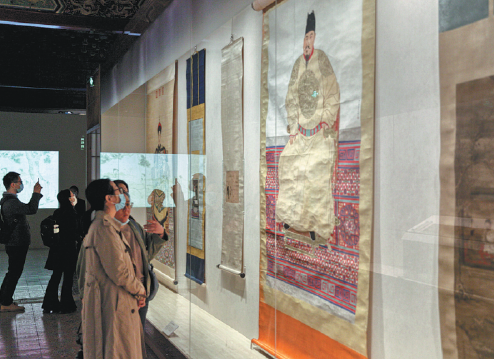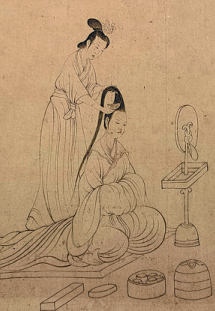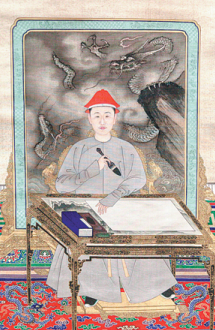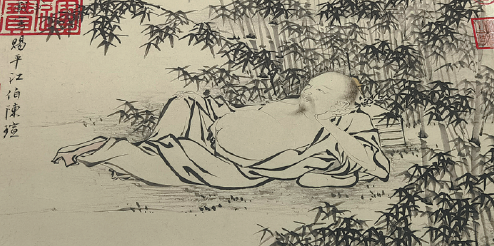Capturing the ages
A painting exhibition at the Palace Museum showcases important figures from ancient China, Wang Kaihao reports.

They are emperors, sages, officials, wartime heroes and heroines, and others in Chinese history. And, painting is one of the best ways to eulogize them.
In the Hall of Literary Brilliance (Wenhua Dian), the painting gallery at the Palace Museum in Beijing, also known as the Forbidden City, an exhibition opened on May 1 to showcase important Chinese figures through 55 ancient artworks.
On Paragons of the Nation: Figure Paintings From Across the Ages in the Palace Museum Collection, which runs through June, many exhibits are newly shown.
The Forbidden City was China's imperial palace from 1420 to 1911, and the paintings were collected by the ruling royal families.
"Since ancient times, painting important figures has been valued for its social function to educate people and give a realistic depiction of life," says Ma Shunping, the exhibition's curator and a researcher at the department of painting and calligraphy at the museum.
"The masters of ancient Chinese art were excellent in painting important figures," he says.
An iconic artist is Gu Kaizhi (348-409) from the Eastern Jin Dynasty (317-420), credited for the piece Admonitions of the Instructress to Court Ladies, simply known as the Admonitions Scroll. The painting illustrated a fourth-century poetic text left by the official Zhang Hua, which offered advice to women in the royal court, and made it better understood through 12 stories in pictures.
With Gu's original painting believed to have disappeared, a Song Dynasty (960-1279) monochrome facsimile on show gives people an idea about that masterpiece.
Ma says this 6-meter-long painting is being fully unrolled to the public for the first time and is a key reference for studies on the evolution of Chinese painting.
A presumably Tang Dynasty (618-907) color copy of the Admonitions Scroll, drawn on silk, was taken to the United Kingdom around 1900 when Beijing was invaded by the Eight-Nation Alliance. It is now housed in the British Museum. However, three sections of the work of a total 12 have been lost. After arriving in London, it was separated into three pieces and mounted on wooden lattices rather than maintaining its original appearance, Ma says.
"This exhibited piece in the Palace Museum is a unique example for us to have a full view of the milestone work by Gu," he says.
Historical icons
Highlights of the exhibition include some epoch-making male figures, such as Confucius, who encouraged scholars to serve the country rather than staying in hermitages, the Great Yu, a legendary ruler who united China in ancient times, and Zhao Kuangyin, the founder of the Song Dynasty.
Ma has also set a section to tell women's stories. Four Song-era works, including the Admonitions Scroll, are on display in the gallery and make up for a highlighted section, because the dynasty is usually seen as an apex of painting historic figures in China.
More displayed paintings from other dynasties portray famous women in China, such as Mulan, a legendary heroine who disguised herself as a man to serve in the army and became known worldwide through Disney productions based on her story, and Wang Zhaojun, one of the "four beauties "of ancient China who was honored for promoting friendship between two ethnic groups through her marriage.
"In ancient China, a lineal primogeniture system was the foundation of royal rule, so women played a key part in politics," Ma says.
"It would be unfair if we only focused on men, who are more visible in historical records, when selecting paintings of important figures."
Nevertheless, he adds, the original purpose when creating these paintings during imperial times was to exhort women to behave within certain norms and therefore restrict their rights.
"If the women in royal court executed their power within a political order and fulfilled their role in the ruling system, they would be considered virtuous by the emperor," he says.
Biographies of Exemplary Women, also a Song Dynasty facsimile of Gu's work, tells of "virtuous" stories of women, hailing them for their wisdom and kindness.
"The painting also has a huge importance for historical studies, apart from its artistic value," Ma says.
"Costumes and objects appearing in the pictures even bear characteristics from the Han Dynasty (206 BC-AD 220), echoing archaeological discoveries today."
This feature may indicate that Gu also copied a painting from an earlier period. Ma says many such artists made copies of paintings of ancient figures through history due to the significance of the morals surrounding them.
However, as painters sometimes tried to display their original creativity, they accidentally fell into anachronism, depicting a different period.
For example, an exhibited Ming Dynasty (1368-1644) portrait is of Yue Fei, a Song general known for his loyalty to empire and devotion to recovering lost territory. The painter ignored Yue's traditional image in martial attire and made him sit and read a book in the painting, but mistakenly gave him a Ming official's robe.
Nevertheless, for rulers who wanted to reveal their expectations through paintings, historical accuracy from centuries earlier may not have to be their first concern, and they were sometimes dissatisfied to simply be patrons.
Zhu Zhanji (1399-1435), a Ming Dynasty emperor, was one such fine arts enthusiast. In his own painting, he portrayed the third-century royal prime minister and strategist Zhuge Liang as a man lying amid bamboo forests in leisure.
Coincidentally, in another exhibit, Zhu's portrait drawn by an anonymous Ming painter, this emperor is seen as a hunter in the wild, which further shows his longing for a free life beyond the throne.
Evolution of styles
Despite the painting of important figures being an early genre in traditional Chinese art, its status faded after the Yuan Dynasty (1271-1368), when that format began to boom in contemporaneous Europe.
Ma attributes the reason to the rise of Chinese literati paintings-those drawn by scholars, officials or writers-at that time.
"The literati preferred a symbolic and conceptual style that emphasized an elegant atmosphere rather than a realistic portrait of details as shown in the painting of historic figures," he says.
"Consequently, landscape painting, which better reveals philosophy, values and cultural cultivation, was favored by them."
Professional painters might be more skillful in meticulously portraying people's facial expressions and folds on clothes, but, in the art circle, they had to give way to those literati. That partially explains why many exhibits have no information of their creators' names.
"The painting of figures continued to thrive within royal courts of the Ming and Qing (1644-1911) dynasties," Ma says. "But the painters following the emperors' order had little room to mix in their personal styles."
During this time, the painting of figures tended to be more connected with folk art and ordinary people's lives. For instance, a displayed Ming portrait of Zhang Fei, a military general from the third century, mixes his image with elements of traditional New Year woodcut paintings, which appear on people's doors.
Ma says the ongoing exhibition is the first phase of a series in the Wenhua Dian gallery that focuses on ancient Chinese figures through painting. Another three exhibitions, each lasting two months, will be presented through the autumn of 2022, respectively on hermits, ordinary women and urban life.
Last year, the four exhibitions were planned to run in the Meridian Gate Galleries, the biggest exhibition space in the Palace Museum, as a tribute to the 600th anniversary of the completion of the Forbidden City. However, the COVID-19 pandemic disturbed the original schedule, and the exhibitions are being held one after another in the Wenhua Dian Gallery.
Due to COVID-19 restrictions, up to 3,000 visitors are allowed daily in the gallery-2,000 in the morning and 1,000 in the afternoon. Reservations are needed in advance via gugong.ktmtech.cn or the official account of the Palace Museum on WeChat, at no extra charge.


































